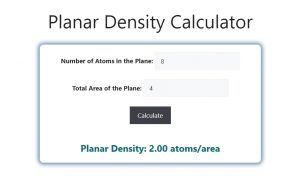About Planar Density Calculator (Formula)
The Planar Density Calculator is a useful tool for scientists, engineers, and students studying material properties and crystallography. Planar density refers to the number of atoms situated in a given area of a crystal lattice. Understanding planar density is crucial for determining material characteristics such as strength, ductility, and conductivity. This article will provide insight into the formula used in the Planar Density Calculator, explain how to use it, offer a practical example, and answer frequently asked questions.
Formula
The formula for calculating planar density is:
Planar Density (PD) = Number of Atoms in the Plane (A) / Total Area of the Plane (PA)
In this formula:
- Number of Atoms in the Plane (A) refers to the count of atoms that lie within a specified plane of the crystal.
- Total Area of the Plane (PA) is the area over which the atoms are distributed, typically measured in square units such as square angstroms or square nanometers.
How to Use
Using the Planar Density Calculator is straightforward. Follow these steps:
- Determine the Number of Atoms: Count the number of atoms present in the specified plane of the crystal.
- Measure the Total Area: Calculate the total area of that plane. Ensure that the area is measured in consistent units.
- Input the Values: Enter the Number of Atoms and Total Area into the calculator.
- Calculate Planar Density: Click the calculate button to obtain the planar density of the material.
Example
Let’s illustrate how to use the Planar Density Calculator with a practical example:
- Values:
- Number of Atoms in the Plane (A): 8
- Total Area of the Plane (PA): 4 square nanometers
- Using the Formula:
Planar Density (PD) = Number of Atoms in the Plane (A) / Total Area of the Plane (PA)
PD = 8 / 4
PD = 2 atoms per square nanometer
In this example, the planar density of the material is 2 atoms per square nanometer.

FAQs
- What is planar density?
Planar density measures the number of atoms per unit area in a crystal lattice plane. - Why is planar density important?
Planar density helps in understanding the physical properties of materials, such as strength and reactivity. - How is planar density calculated?
Planar density is calculated by dividing the number of atoms in a plane by the total area of that plane. - What units are used for planar density?
Common units include atoms per square angstrom (Ų) or atoms per square nanometer (nm²). - Can planar density vary between materials?
Yes, planar density can vary significantly depending on the type of material and its crystal structure. - What is the significance of a high planar density?
A high planar density typically indicates stronger bonding and greater material stability. - How does temperature affect planar density?
Temperature changes can alter atomic arrangements and densities, affecting the calculated planar density. - Can I use this calculator for complex crystal structures?
Yes, but you may need to adapt your counting method for different atomic arrangements. - What types of materials can be analyzed with planar density?
Planar density is applicable to metals, semiconductors, ceramics, and various other crystalline materials. - Is planar density related to other material properties?
Yes, it is related to properties such as ductility, malleability, and thermal and electrical conductivity. - What is the difference between planar density and atomic density?
Planar density refers to a specific plane’s atomic arrangement, while atomic density measures the number of atoms in a given volume. - How do I measure the total area of the plane?
The total area can be calculated geometrically based on the dimensions of the crystal plane being analyzed. - Is planar density the same for all crystallographic planes?
No, different planes in a crystal may have different planar densities due to atomic arrangement variations. - What challenges might I face when calculating planar density?
Challenges may include accurately counting atoms and measuring areas, especially in complex structures. - Can planar density influence the reactivity of a material?
Yes, the arrangement and density of atoms can impact how materials interact chemically. - How can planar density affect material applications?
Materials with higher planar densities may be preferred in applications requiring strength and durability. - Are there software tools available for calculating planar density?
Yes, several computational software tools can assist in modeling crystal structures and calculating planar density. - What role does planar density play in materials science?
Planar density is crucial in understanding the mechanical and thermal properties of materials. - Can planar density help predict material behavior under stress?
Yes, higher planar densities often correlate with improved mechanical performance under stress. - Where can I find more resources on planar density?
Academic journals, textbooks on crystallography, and materials science websites provide valuable information on planar density and related topics.
Conclusion
The Planar Density Calculator is an invaluable resource for analyzing the atomic arrangement within materials. By understanding how to use this calculator and the significance of planar density, researchers and students can gain deeper insights into material properties and their implications in various fields. Whether in academic studies or industrial applications, the knowledge of planar density plays a vital role in advancing material science and engineering.